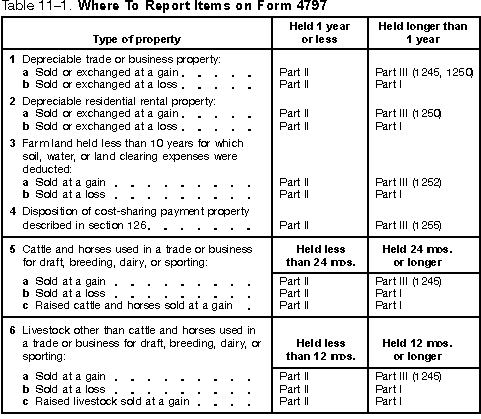| Publication 225 |
2001 Tax Year |
Section 1231 Gains & Losses
Section 1231 gains and losses are the taxable gains and losses from
section 1231 transactions--generally, dispositions of property
used in business. Their treatment as ordinary or capital depends on
whether you have a net gain or a net loss from your section 1231
transactions in the tax year.

 If you have a gain from a section 1231 transaction, first determine
whether any of the gain is ordinary income under the depreciation
recapture rules (explained later). Do not take that gain into account
as section 1231 gain.
If you have a gain from a section 1231 transaction, first determine
whether any of the gain is ordinary income under the depreciation
recapture rules (explained later). Do not take that gain into account
as section 1231 gain.
Section 1231 transactions.
Gain or loss on the following transactions is subject to section
1231 treatment.
- Sale or exchange of cattle and horses. The cattle
and horses must be held for draft, breeding, dairy, or sporting and
held for 2 years or longer.
- Sale or exchange of other livestock. This
livestock must be held for draft, breeding, dairy, or sporting and
held for 1 year or longer. Other livestock includes hogs, mules,
sheep, and goats, but does not include poultry.
- Sale or exchange of depreciable personal property.
This property must be used in your business and held longer than
1 year. Generally, property held for the production of rents or
royalties is considered to be used in a trade or business. Examples of
depreciable personal property include farm machinery and trucks. It
also includes amortizable section 197 intangibles.
- Sale or exchange of real estate. This property
must be used in your business and held longer than 1 year. Examples
are your farm or ranch (including barns and sheds).
- Sale or exchange of unharvested crops.
The crop and land must be sold,
exchanged, or involuntarily converted at the same time and to the same
person, and the land must have been held longer than 1 year. You
cannot keep any right or option to reacquire the land directly or
indirectly (other than a right customarily incident to a mortgage or
other security transaction). Growing crops sold with a lease on the
land, even if sold to the same person in a single transaction, are not
included.
- Distributive share of partnership gains and losses.
Your distributive share must be from the sale or exchange of
property listed earlier and held longer than 1 year (or for the
required period for certain livestock).
- Cutting or disposal of timber. You must treat the
cutting or disposal of timber as a sale, as described in chapter 10
under Timber.
- Condemnation. The condemned property (described
in chapter 13) must have been held longer than 1 year. It must be
business property or a capital asset held in connection with a trade
or business or a transaction entered into for profit, such as
investment property. It cannot be property held for personal use.
- Casualty or theft. The casualty or theft must
have affected business property, property held for the production of
rents or royalties, or investment property (such as notes and bonds).
You must have held the property longer than 1 year. However, if your
casualty or theft losses are more than your casualty or theft gains,
neither the gains nor the losses are taken into account in the section
1231 computation. Section 1231 does not apply to personal casualty
gains and losses. See chapter 13 for information on how to treat these
gains and losses.
Property for sale to customers.
A sale, exchange, or involuntary conversion of property held mainly
for sale to customers is not a section 1231 transaction. If you will
get back all, or nearly all, of your investment in the property by
selling it rather than by using it up in your business, it is property
held mainly for sale to customers.
Treatment as ordinary or capital.
To determine the treatment of section 1231 gains and losses,
combine all your section 1231 gains and losses for the year.
- If you have a net section 1231 loss, it is an ordinary
loss.
- If you have a net section 1231 gain, it is ordinary income
up to your nonrecaptured section 1231 losses from previous years,
explained next. The rest, if any, is long-term capital gain.
Nonrecaptured section 1231 losses.
Your nonrecaptured section 1231 losses are your net section 1231
losses for the previous 5 years that have not been applied against a
net section 1231 gain by treating the gain as ordinary income. These
losses are applied against your net section 1231 gain beginning with
the earliest loss in the 5-year period.
Example.
In 2001 Ben has a $2,000 net section 1231 gain. To figure how much
he has to report as ordinary income and long-term capital gain, he
must first determine his section 1231 gains and losses from the
previous 5-year period. From 1996 through 2000 he had the following
section 1231 gains and losses.
|
Year |
Amount |
| 1996 |
-0- |
| 1997 |
-0- |
| 1998 |
($2,500) |
| 1999 |
-0- |
| 2000 |
$1,800 |
Using this information, Ben figures how to report his net section
1231 gain for 2001 as shown below.
| 1) |
Net section
1231 gain (2001) |
$2,000 |
| 2) |
Net section 1231 loss
(1998) |
($2,500) |
|
| 3) |
Net section 1231 gain
(2000) |
1,800 |
|
| 4) |
Remaining net section 1231
loss |
($700) |
|
| 5) |
Gain treated as ordinary income |
|
$700 |
| 6) |
Gain
treated as long-term capital gain |
$1,300 |
His net section 1231 loss from 1998 is completely recaptured in
2001.
Previous| First | Next
Publication Index | IRS-Forms Main | Home
|
